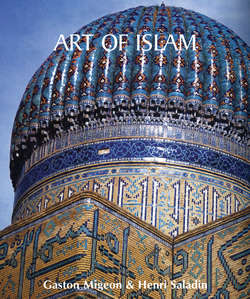Читать книгу Art of Islam - Gaston Migeon - Страница 22
Architecture
C–Iran and the Persian School
ОглавлениеThe Friday Mosque, 8th-17th centuries.
Isfahan, Iran.
The art of the early caliphs, whose splendour has been revealed only by historians, and which spread to the south and the west, was equally crucial to the development of Persian art, given that Persia had initially been a province of the vast empire of the caliphs. In spite of its continual originality, demonstrated initially through Shiism and its ingenious and abundant but varied works of art, Persia had no political independence as a state for close to nine hundred years. A province under the caliphate, Persia was in effect ruled by caliphs through local dynasties including the Tahirids, the Saffarids, the Samanids, the Deilemits, the Ghaznavids, the Buyids, the Seljuqs led by Togrul Beg, and later the Kharismians. However, it was finally subjugated by the Mongols under Genghis Khan in the 13th century. Although the il-Khanids or the dynasty of Hulagu’s descendants for some time built a peculiar kingdom comprising Persia and part of Anatolia, this kingdom was razed following an invasion by Tamerlane. In the 15th century, the Turcoman Qara Quyunlu (Black Sheep) dynasty was created by Kara Yusuf. In 1468, however, the Aq Quyunlu (White Sheep) dynasty replaced it and put the Turcomans back on the Persian throne. It was only in 1502 that Shah-Ismaïl, of the Safavid dynasty, gave Persia its independence and a prosperity which reached its height under the reign of Shah Abbas. This dynasty disappeared in 1722 and was replaced by an Afghan family which, notwithstanding the remarkable rulers it produced, was replaced by Nadir Shah. After the relatively short reigns of Adil Shah and Shah Rukh, Kerim Khan, from the tribe of the Zends, gave power to his family, leaving Shah Ismaïl of the Safavid dynasty to rule only in principle. After three short successive reigns, this small dynasty was defeated by Agha Mohammad Khan of the Qajar tribe.
This short historical review of Persia is crucial to demonstrating that despite the diverse origins of its Muslim rulers, Persian art witnessed a constant evolution, not only in Persia per se, but also in Turkestan, which depended on Persia’s architectural influence. In effect, it was impossible to find architects from Turkestan’s nomadic tribes. It is a known fact that when Tamerlane wanted to adorn Samarkand, he had to resort to Persia’s finest architects and the monuments that they erected there, for the great conqueror and his successors are by all standards a reflection of Persia’s architectural glory.
Ancient and pre-Islamic Persian architecture is well-known today thanks to a good number of extant, impressive monuments. Nevertheless, Persian Muslims were able to decorate their buildings, even public buildings, in such a way as to give them a character entirely distinct from the one that can be seen on Achaemenid or Sassanian monuments, and the variety of construction programmes with which they had to comply left us with an even greater number of different types of buildings that we cannot find in Egypt, Syria or the Maghreb.
Buildings in Persia, Mesopotamia and Turkistan were influenced by two building systems, both of which stem from earlier traditions. The platband with its columns and ceilings includes the roof framing and timber construction, the walls of which can either be made of baked or unbaked bricks, rough stones, or half-timberings covered with earth and bricks. This system of construction comes from Assyrian and Median art. Vaulted buildings, with arcades and without monolithic columns, from Chaldean and Persian traditions as well as Sassanian art, have only brick pillars as isolated support points, built on either a circular, octagonal, or square plan flanked by four attached columns. The Persians preferred the vault system because structural timber was absolutely lacking in a greater part of the country. Therefore, they quickly became very skilled at such construction. As a logical outcome of the construction system used, Persian architects concluded that the rib, which crimps the beam fillings and forms a resistant self-supporting network, is the most important component of the vault. Owing to this subdivision of the total surface area of the vault, construction work was made easier than that of huge barrel or groined vaults, good examples of which are found in extant ancient hot baths. They had at their disposal two types of artificial materials: baked and unbaked bricks.
